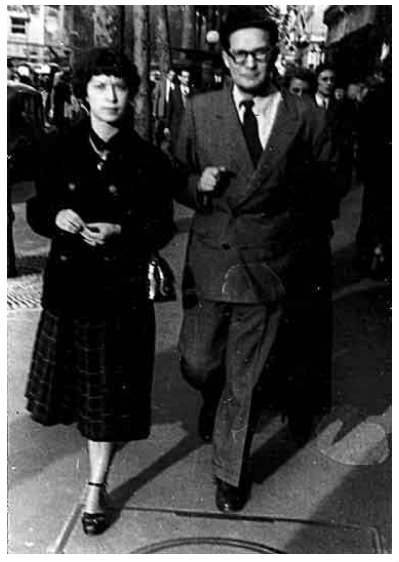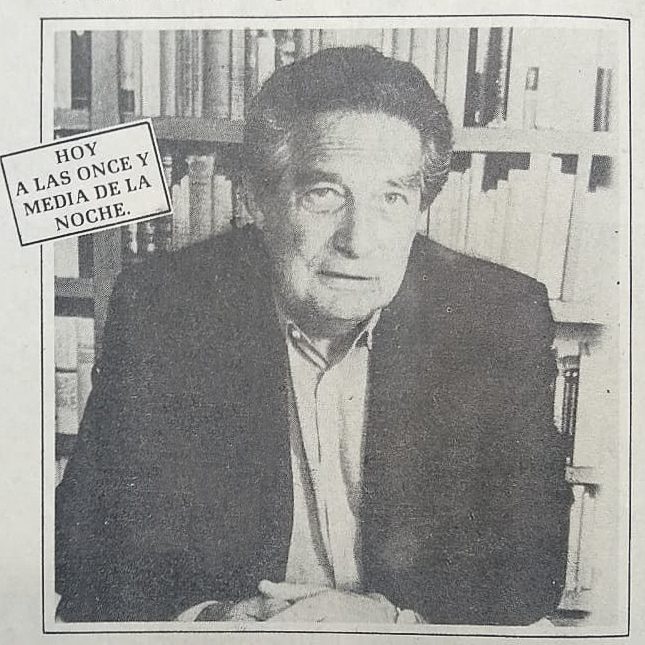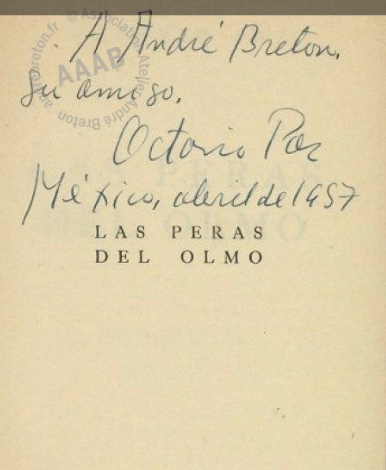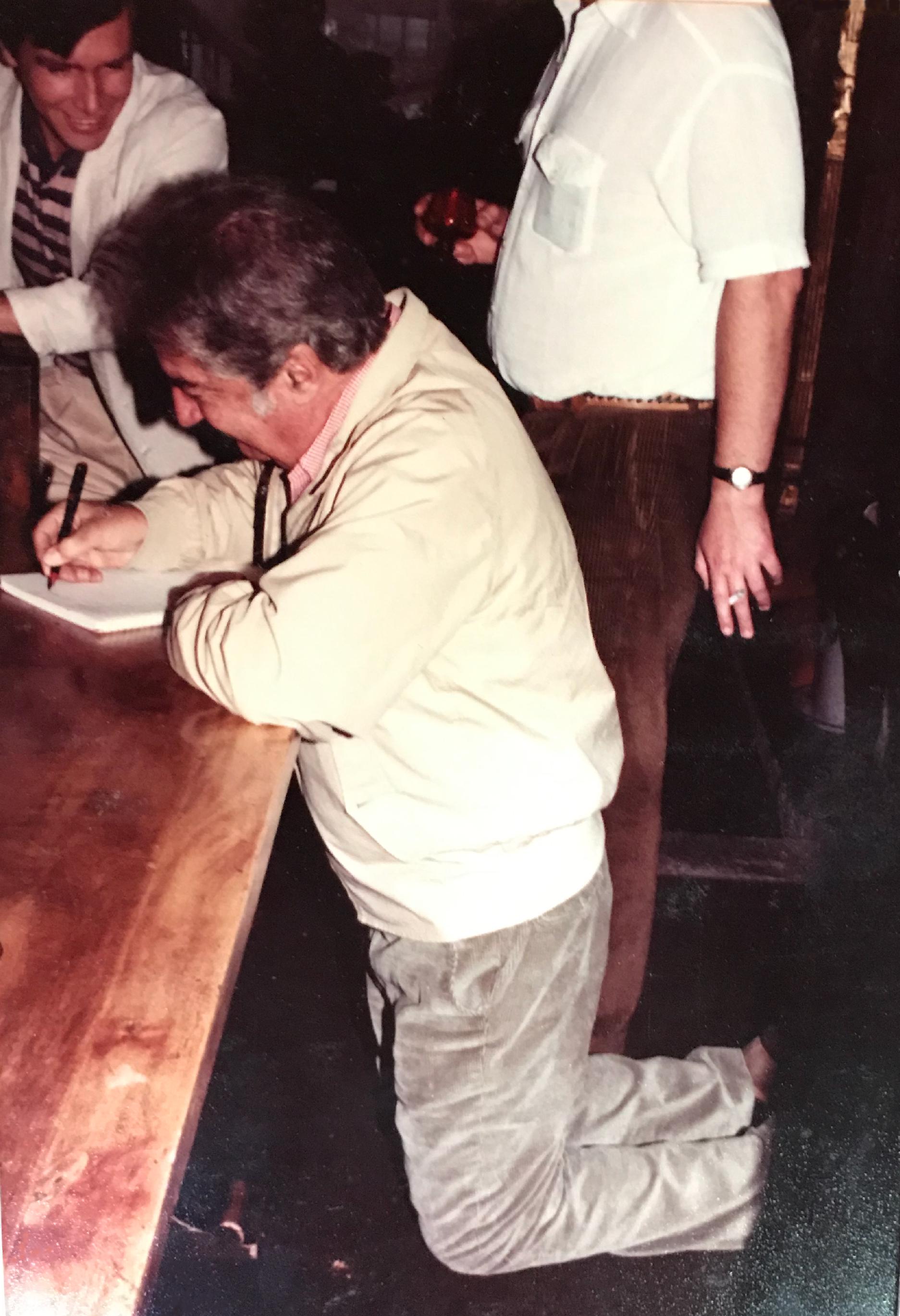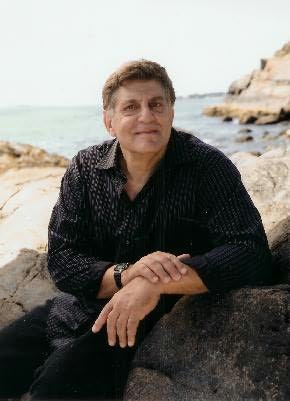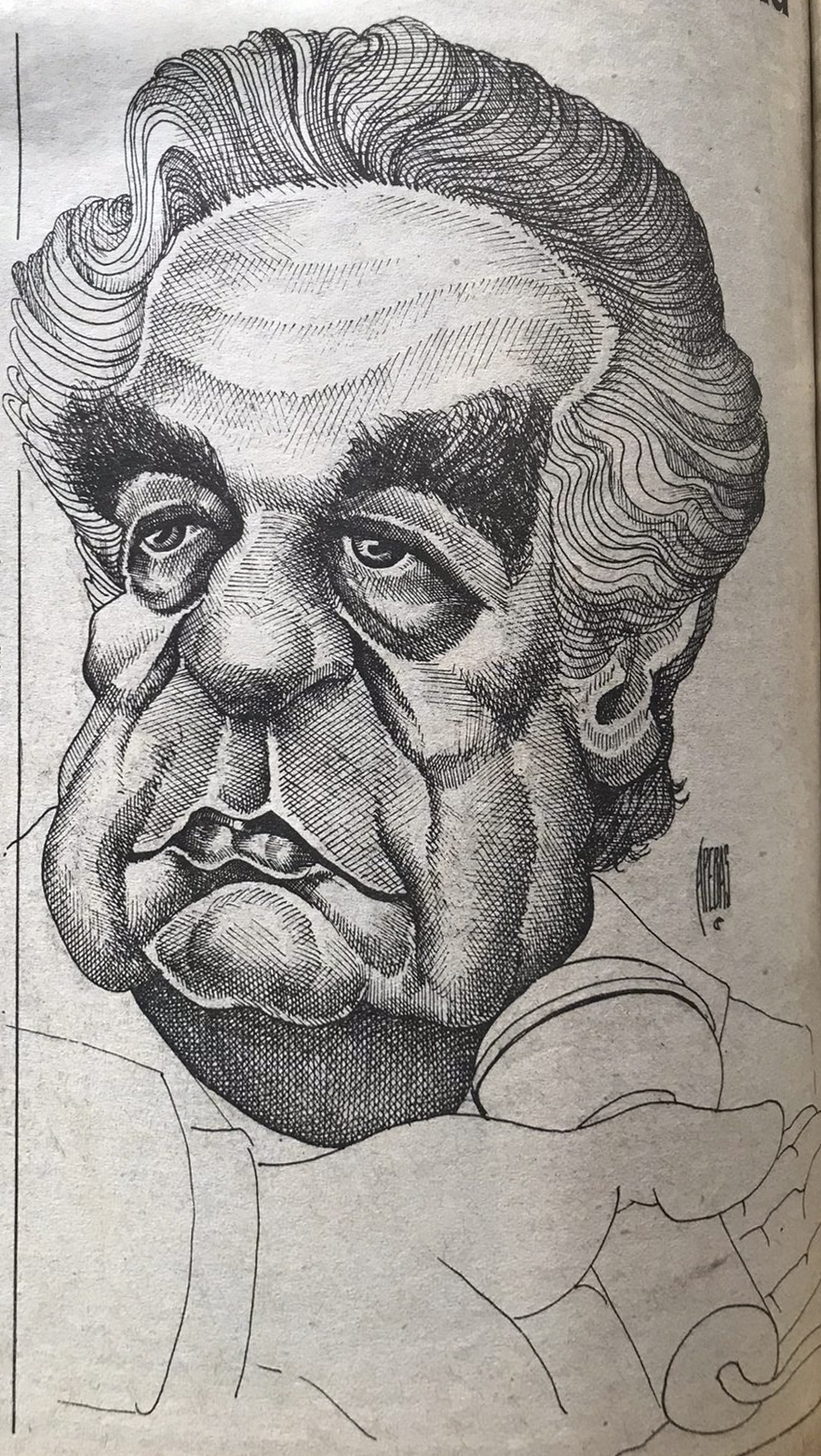Octavio Paz, Surrealism and the Magic of the Word
Melanie Nicholson
Año
2012
Tipología
Análisis y crítica
Temas
Recontextualizaciones
Lustros
2010-2014
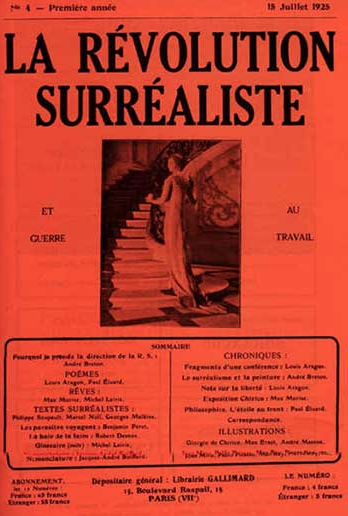
Este ensayo apareció originalmente en La palabra entre el águila y el sol: el surrealismo y la obra de Octavio Paz (Rocío Luque y Carmen Rivera, editoras. Universidad del Turabo, Puerto Rico, 2012).
The oldest of
the old follows behind
us
in our thinking and yet it comes to
meet
us.
–Martin Heidegger
In his essay “André Breton o la búsqueda del comienzo,” written on the occasion of Breton’s death, Octavio Paz observed: “Las ideas de Breton sobre el lenguaje eran de orden mágico. No solo nunca disinguió entre magia y poesía sino que pensó siempre que esta última era efectivamente una fuerza, una sustancia o energía capaz de cambiar la realidad” (217). Like Breton, Paz maintained a lifelong fascination with the connection between poetry and magic, and surrealism was for him the modern current of thought that helped clarify—and resurrect—this connection. Paz claims that with the advent of surrealism, “La actividad poética vuelve a ser una operación mágica” (“El surrealismo” 139). Like the surrealists, Paz grounds his thought in the ancient belief in the logos as a power capable of transforming the world. Calling into question the Saussurian premise that language is an arbitrary convention linking signifier and signified, Paz returns to the archaic notion of the direct correspondence between words and things, a correspondence that allowed words to effect real changes in the material world. “Nadie puede sustraerse a la creencia en el poder mágico de las palabras,” he declares in his seminal treatise on poetry, El arco y la lira. Calling the modern reserve toward language a mere “actitud intelectual,” Paz concludes that “La confianza ante el lenguaje es la actitud espontánea y original del hombre: las cosas son su nombre” (51).
In Western thought, a direct or unmediated relationship between words and the things they designated prevailed well into the Renaissance. In Les Mots et les choses [The Order of Things], Michel Foucault tells us that “In its original form, when it was given to men by God himself, language was an absolutely certain and transparent sign for things, because it resembled them. The names of things were lodged in the things they designated [. . .]” (36). But since the seventeenth century, a rational (and limiting) view of language has prevailed over the notion of a direct, unmediated power. What, then, do Paz and the surrealists—following in a long line from the German Romantics through Baudelaire and Rimbaud—mean when they refer to language as “el arte mágico”? How should we understand the fact that the direct correspondence between word and thing is a belief that still survives in modern poetics, having long ago been discredited by science? These questions lead us to ask, finally, how we are to characterize and comprehend the poetic belief system of Octavio Paz, widely regarded as Mexico’s preeminent twentieth-century writer and thinker.
In this essay I argue that Paz reformulates surrealist ideas, together with ideas gleaned from the Spanish-American modernistas, in order to craft a poetics that presents “verbal magic” in coherent and even rational terms. The centerpiece of this poetics is Paz’s observation that the essence of magic is change —metamorphosis— and that this change can be effected by our reaction to a work of art: “Le pedimos al arte el secreto del cambio y buscamos en toda obra, cualesquiera que sean su época y su estilo, ese poder de metamorfosis que constituye la esencia del acto mágico” (“Arte mágico”, 155). The preeminent critic Jason Wilson ties the belief in poetry as a catalyst for change to Paz’s surrealist affinities: “All Paz’s writings envisage some act of communion beyond words, a faith that poetry changes the poet and the reader, ushering in the poetic society based on love, liberty and desire, the waking dream lived in broad daylight” (5).
In the case of poetry, Paz sees two interrelated forces at work in acts of verbal magic: analogy and rhythm. Modern analogy, he claims, returns human thought to its mythical dimension. “La antigua noción de la analogía reaparece: la naturaleza es lenguaje y éste, por su parte, es un doble de aquélla,” says Paz in his essay on Breton (217). Paz’s study of analogy and rhythm takes the surrealist principle of the resolution of opposites and broadens it into an explanation of dynamic human interaction with the world. In this view, rhythm is a representation of the movement between opposites on perceptual, sensual, and verbal levels. By examining these notions in his essays on aesthetics and in certain of his poetic texts, we can see how Paz takes his place as the poet-thinker of surrealist thought.
I. Paz and the Surrealist Conception of Verbal Magic
In 1955, Breton devised a questionnaire meant to explore the double theme of art and magic, and sent it to numerous intellectuals and writers. Paz’s own answers to these questions, reproduced under the title “Arte mágico” in his collection of essays Las peras del olmo (1957), constitute a sort of aesthetic theory and, as such, can serve as a touchstone for our examination of verbal magic. I will discuss several of these answers in an attempt to codify Paz’s ideas about poetic language, before proceeding to analyze the respective roles of analogy and rhythm in fleshing out his poetics of verbal magic.
Breton’s first question establishes a relationship between the ancient mage —wizard, shaman, or magician— and the modern artist, both of whom speculate on the means of “casting a spell over the universe”; he then asks his interlocutors to comment on the presence of such a relationship in their own work (“Arte mágico” 152). In his answer, Paz alludes to modern anthropology, which has effectively debunked Frazer’s notion of a “magical age” that predated a later age of reason. He insists, instead, that from the most remote origins of human civilization to the modern age, “las creencias mágicas se hallan inextricablemente ligadas a todas las actividades humanas. Secreta o abiertamente, la magia circula por el arte de todas las épocas [. . .]” (152). At this point he introduces the all-important notion of metamorphosis—the capacity to bring about real change in the world—which has always been the goal of magic and which he also applies to the literary experience: “Entre magia y arte hay un flujo y reflujo continuo: la poesía descubre correspondencias y analogías que no son extrañas a la magia, para producir una suerte de hechizo verbal; al mismo tiempo, poeta y lector se sirven del poema como de un talismán mágico, literalmente capaz de metamorfosearlos” (153)[i]. It is pertinent to recall at this juncture Rimbaud’s belief in l’alchemie du verbe, as well as his insistence that Il faut changer la vie. Taken together, these ideas constitute the surrealist belief that one can use language creatively to bring about a shift in material reality. Paz adopts this belief, but goes beyond (and even against) the surrealists to seek out rational causes for its validity.
Breton’s second question poses the problem of magic in the modern world. This question evokes the early twentieth-century interest in the magical practices of “primitive” societies reflected in the work of anthropologists such as Claude Lévi-Strauss, Lucien Lévy-Brühl, and Bronislav Malinowski, as well as the aesthetic interest in non-Western cultures pursued by European avant-garde artists, Breton not the least among them. Breton asks whether magic —the attempt to reconcile the powers of nature with those of human desire— can be rehabilitated, and if so, could such a rehabilitation be dangerous, even disastrous? Given those potentialities, he goes on to ask, is it even desirable? (154). Paz’s response remits us to the origins of magical thought in a monistic and vitalistic world view, a conception of the cosmos as a unified whole or “un todo en el que las partes están unidas por una corriente de secreta simpatía. El todo está animado y cada parte está en comunicación viviente con ese todo” (154). He refers here to the fundamental premise of all esoteric or Neoplatonic thought, according to which the divided, fallen, or fragmented nature of the universe gives rise to beliefs and practices through which humans seek to recover a sense of wholeness[2]. It is in the nature of reality, Paz goes on to say, that all objects desire to transform themselves, to become other. The magical object brings this desire to the surface of consciousness: “nos invita a cambiar y a ser otros sin dejar de ser nosotros mismos” (154; emphasis in original). Paz intimates here that by recognizing the essential unity of the cosmos (a belief rejected by most Western, especially post-Cartesian thought), we can at least temporarily dissolve the boundaries between subject and object, achieving the desired otherness. This preoccupation with otherness, and thus with the dissolution of the self, becomes a touchstone of Paz’s thought, tying twentieth-century structuralism to the esoteric worldview of the German and English romantics, and even to Buddhism[3].
Paz clarifies at this point that the proposed revaluation of magical thought does not imply a return to pre-literate practices, although he acknowledges that we can no longer consider such practices “como meras y estúpidas supersticiones” (155). In fact, he makes the overarching claim that the kind of magical thinking he vindicates here forms the basis of philosophical systems, religious dogma, and even science itself. Though particular systems of thought have arisen and fallen over the course of human history, he says, they have left intact the original sense of universal unity and sympathy (155). With this statement, Paz’s claims ascend to a level of abstraction where they are virtually impossible either to validate or to refute. Indeed, Paz the thinker here blends imperceptibly into Paz the poet, in ways that may exasperate and confound the reader[4]. Yet in true surrealist fashion, Paz demands of us that we dissolve facile antinomies such as that of “thinker-philosopher vs. poet” as we consider his propositions.
It is important to distinguish this Neoplatonic world view from a vague sort of utopian desire for universal harmony. Paz locates the primordial sense of wholeness on a continuum between two extremes: solitude and community. Historically, he claims that to be human is to feel “separados, desarraigados, arrojados al mundo,” or, alternatively, to inhabit the center of that world “con la naturalidad del que regresa a su casa” (155). Writing at the mid-point of the twentieth century —as a Mexican largely alienated from his own society, within a larger Western “wasteland” characterized by alienation— Paz sees solitude as the primary mode of his age: “En nuestro tiempo la nota predominante es la soledad. El hombre se siente cortado del fluir de la vida; y para compensar esta sensación de orfandad y mutilación acude a toda clase de sucedáneos: religiones políticas, embrutecedoras diversiones colectivas, promiscuidad sexual, guerra total, suicidio en masa, etcétera” (155). This is where Paz’s claims for poetry as verbal magic descend from the plane of abstraction to that of action. His insistence on magical thinking, far from being an intellectual or spiritual fantasy gleaned from his reading about archaic societies, is in fact a cry for a certain type of response to the lived realities of the Western world in the 1950s.
But by what means will this response be initiated? Here, in an argument whose debt to surrealism is patent, Paz ties his desire for a reintegrated human existence to the notion of inspiration, and from there returns to his defense of magic. In a post-Cartesian, especially a post-Nietzschean world in which the gods or the force of the numen cannot be evoked, humans are faced with the problem of explaining inspiration (a phenomenon that is still observable, if not experienced, by all). The surrealists, says Paz, brought our understanding of inspiration in line with a rational explanation of the world by discarding the notion of inspiration as religious or superstitious mystery and by locating the seat of inspiration instead within man himself. “Pues bien,” he concludes, “nuestra actitud ante la magia debe orientarse en el mismo sentido: hay que reducirla a términos humanos, examinarla como un hecho que se da en la consciencia del hombre, y aun más, considerarla como lo que es realmente: uno de los constituyentes de esa consciencia” (158).
This is where, at last and unequivocally, Paz’s conception of magic is channeled into his aesthetics. In answer to Breton’s fourth question —“Ante un objeto perteneciente al ‘arte mágico’, ¿cuáles son sus métodos de examen o de conocimiento?”— Paz insists upon the value of the immediate, subjective response to a work of art, which he calls “la experiencia directa, desnuda y sin intermediarios” (158). This is because only in this unmediated fashion can we as readers/listeners/spectators experience the sense of lo otro that invites us to step outside of ourselves (though we may feel repulsed) and merge with that other being or otherness. Paz the poet and Paz the aesthetic thinker are again revealed in his very language he uses to describe this encounter:
Vértigo, extrañeza, reconocimiento. Horror y, simultáneamente, deseo de penetrar en aquello que de tal modo ataca y disgrega nuestra certidumbre de ser conciencia personal y autónoma. Los dos movimientos contrarios se reconcilian en el deseo de dar el “salto mortal” y alcanzar la “otra orilla”. En suma, la gama de sensaciones —asombro, horror, vértigo, fascinación, caída en el objeto— evoca siempre la vieja imagen de la metamorfosis. (158)
Paz had learned from the surrealists that inspiration, like magic, is a metamorphosis that takes place within the individual, precisely at the moment of contact with a work of art that propels him outside of himself. This “magical” (i.e., irrational but powerful) act of confronting our otredad is triggered by two particular means: analogy and rhythm.
II. Poetry as Analogy and Rhythm
Foucault points out that till the end of the sixteenth century, human knowledge was based upon the fundamental concept of resemblance: the universe was to be explained principally by means of tracing similarities between things. Of the four primary types of resemblance that he documents, Foucault insists that analogy holds the greatest sway: “Its power is immense, for the similitudes of which its treats are not the visible, substantial ones between things themselves; they need only be the more subtle resemblances of relations. Disencumbered thus, it can extend, from a single given point, to an endless number of relationships” (21). Foucault suggests here that beyond the immediate sense of “this is like that,” analogy allows us to imagine that “this is like that and that and that,” or conversely, that “these many things are like this one thing.” Analogical thought is thus grounded in a view of original unity in which all things are linked to all other things, whether or not those links are perceptible through the ordinary senses. Within the modern Western literary tradition, the German and English romantics were responsible for a revival of analogical thought, which was subsequently filtered through Baudelaire and the French symbolists, reaching the twentieth century as one tributary of the surrealist river of thought[5].
For his part, Octavio Paz came to analogy through these channels, but also through his reading and systematic study of the Spanish-American modernistas, especially Rubén Darío. Darío’s personal approach to poetry went beyond those trends generally applicable to modernista poets by placing special emphasis on analogy: For him, says Cathy Jrade, “If the universe is one harmonious extension of God and both individuals and the universe are made in God’s image, all the elements of creation are analogous and correspond to each other; they are signs to be ‘read’ and deciphered” (18). In the history of Modernist criticism, it was Paz himself who first clearly identified Darío’s debt to the esoteric traditions[6]; in turn, Darío’s poetic theories heavily influenced his own. In his discussion of Darío’s Prosas profanas, Paz cites a fundamental tenet of analogical thought: “El lenguaje es un doble mágico del cosmos” (“Sirena” 38). “Language” in this context is not ordinary discursive speech, but poetry, since “por la poesía , el lenguaje recobra su ser original, vuelve a ser música” (38). In short, Paz found in Darío both a theorist who reformulated certain conceptions that fascinated the younger writer (particularly that of analogical thought), and a poet who put a particularly Hispanic lyrical stamp on that thought.
In his introduction to El arco y la lira, Paz uses overtly poetic language to convey his definition of analogy: “Analogía: el poema es un caracol en donde resuena la música del mundo y metros y rimas no son sino correspondencias, ecos, de la armonía universal” (13). The lexicon Paz uses here could have been taken directly from Swedenborg, Novalis, Baudelaire, or Darío: analogy, the music of the world, rhymes, correspondences, universal harmony: taken together, these terms point unerringly to a Neoplatonic world view. What concerns Paz in this set of hermetic commonplaces is poetry, and he calls our attention to it not by talking about poetry but by creating it. The metaphor poema = caracol conjures up for the reader the image of a small, closed-yet-open space whose spiral shape creates tonal resonances when breath or wind is blown into it. The conch shell can literally produce music; its emptiness provides a space to be filled; its location suggests the primordial, infinite, living space of the sea… and so on: in “defining” analogy, Paz has chosen a rich poetic image that sets the reader’s imagination to work. Reading Paz’s definition, we do not so much understand analogy as experience it.
Throughout his life, Paz’s intellectual and creative project was to restore poetry to the status held by magical language (i.e., shamanistic, Delphic, or divinely inspired language) in pre-literate societies. In this spirit, he ties modern poetry to magic by means of analogy: “La operación poética no es diversa del conjuro, el hechizo y otros procedimientos de la magia. Y la actitud del poeta es muy semejante a la del mago. Los dos utilizan el principio de analogía [. . .] (Arco 53). For Paz, in other words, the poetic process is one by which hidden associations are revealed, by which the “correspondences” that link all things become suddenly apparent to the poet (and to his or her reader or listener), without the intervention of rational thought. But how exactly does this occur? The key to the process, according to Paz, lies in the richly complex concept of rhythm, which he examines at length in the chapter entitled “El ritmo” in El arco y la lira (49-67).
Paz claims aphoristically that “La analogía es el lenguaje del poeta. Analogía es ritmo” (Arco 81). We have already seen how poetry works analogically by connecting two entities that non-poetic thought may not have connected. Following this, the equation analogy = rhythm leads us to consider rhythm not in its ordinary sense, as the regular recurrence of verbal or musical beats, but as an actual means of conceiving reality. Paz indeed straightforwardly discounts the conventional acceptance of the word rhythm, claiming that “El ritmo no es medida: es visión del mundo” (Arco 59). The explanation for this lies within a broad conception of language in which words, phrases, and verbal associations engage in a kind of magnetic attraction and repulsion, converging and dispersing according to certain rhythmic principles (Arco 53); in fact, Paz defines the poem as “Objeto magnético, secreto sitio de encuentro de muchas fuerzas contrarias” (Arco 25). For the ordinary speaker or writer, this phenomenon occurs beyond conscious control, occasioning sometimes surprising results. The poet, however, is the conscious user of language who—like the magician—aims deliberately to reproduce the “secret” rhythm that will give him power over words. To a marked degree, poetic creation consists in the “voluntaria utilización del ritmo como agente de seducción” (53). Such a seduction may end with the listener or reader, but it begins with the words themselves:
Aunque el poema no es hechizo ni conjuro, a la manera de ensalmos y sortilegios el poeta despierta las fuerzas secretas del idioma. El poeta encanta al lenguaje por medio del ritmo. Una imagen suscita a otra. Así, la función predominante del ritmo distingue al poema de todas las otras formas literarias. El poema es un conjunto de frases, un orden verbal, fundado en el ritmo. (Arco 65)
What is surprising here is the notion that the poet bewitches language itself, an assertion related to the earlier claim that he “seduces” words. Far from the contemporary notion of poetry as craft, as a conscious making or poiesis, this conception speaks to an ability to harness irrational powers. In doing so, it frees poetry from any sort of formal or structural constraint: even prose or so-called ordinary speech can be poetry if it works primarily as rhythm. As readers of Paz’s essays know well, his critical prose often “seduces language,” causing images and phrases to spark and fire off each other to produce associative rather than logical connections[7].
Perhaps the most fundamental, archetypal rhythm is the one that involves a movement between opposites: opening-closing, inhaling-exhaling, emptiness-fullness, yin-yang, self-other, and so fort[8]. It is here that Paz’s thinking about rhythm aligns him directly with the surrealists: in his essay “El surrealismo” he ties ancient beliefs, esoteric thought, and poetry together in a formulation based on the rhythmic reconciliation of opposites: “Como lo creían los antiguos, y lo han sostenido siempre los poetas y la tradición oculta, el universo está compuesto por contrarios que se unen y separan conforme a cierto ritmo secreto. El conocimiento poético —la imaginación, la facultad productora de imágenes en cuyo seno los contrarios se reconcilian— nos deja vislumbrar la analogía cósmica” (149). In sum, Breton’s hope of “finding and fixing the point” in the mind at which all perceived contradictions are reconciled is for Paz a matter of engaging fundamental rhythms[9].
Paz’s explanation of surrealism by means of rhythm and analogy returns us to our original question: How can poetry truly change reality? We recall that Paz’s answers to Breton’s questionnaire led him to the conclusion that the unmediated, truly subjective experience of a work of art allows the observer to unfold outward toward contact with lo otro, which Paz sees as a fundamental desire of the self. This movement cannot occur within our limited and limiting sense of quotidian time; rather, we must be shifted into what Paz calls archetypal time, the time of myth, since this is a realm that allows both the past and the present to be “cargado de posibilidades” (Arco 62)[10] Put simply, when we create, read, or listen to a poem, its rhythm produces this necessary change in our perception of time. Poetic practice liberates consciousness by returning it to primordial time: “Dejar al pensamiento en libertad, divagar, es regresar al ritmo; las razones se transforman en correspondencias, los silogismos en analogías y la marcha intelectual en fluir de imágenes” (Arco 68). We can now approach a fuller understanding of these transformations by exploring certain examples from Paz’s own lyrical production.
IV. The Poet-Thinker at Work
—cada palabra palpita
(Paz, “Viento entero”)
“La poesía es una de las manifestaciones de la analogía,” says Paz in Los hijos del limo; “las rimas y las aliteraciones, las metáforas y las metonimias, no son sino modos de operación del pensamiento analógico” (86). The ultimate craftsman, Paz is aware of these modes in every poem he writes. But in his role as poet-thinker, he also also thematizes analogy. In “Noche en claro,” a poem from Salamandra that is dedicated to André Breton and Benjamin Péret, a cosmic analogy of immanence is created with the metaphor of the door:
Todo es puerta
basta la leve presión de un pensamiento
Algo se prepara [. . .] (94)
The insistent alliteration of the p pushes the reader forward in anticipation of that “algo,” and the “pressure” exerted in that act has an immediate effect on quotidian time: “Se abrió el minuto en dos / leí signos en la frente de ese instante [. . .]” (94). These lines evoke the return to the archetypal time of which Paz speaks in El arco y la lira, the time in which the past is not a completed series of events but an anticipated future (62). Within this temporal dimension, time itself becomes a text to be read, as the speaker reads signs on the face of the moment that has magically divided itself in two.
But “Noche en claro” is situated in post-war Paris and London, where archetypal time can exist only in tension with profane or historical time. The latter is time marked with human measure —tragically— as “este mismo año enfermo / fruto fantasma que resbala entre las manos del siglo / año de miedo tiempo de susurro y mutilación” (96). Instead of mythical time in which the eternal return can provide meaning, post-war Europe represents a time of sterile repetition: “El tiempo daba vueltas y vueltas y no pasaba / no pasaba nada sino el tiempo que pasa y regresa y no pasa.” Stagnation is represented verbally here through the repetition of the words tiempo, vueltas, pasaba, and pasa (96). At this point, a significant shift occurs in the poem: after seeing a girl with an image of a hand displaying the letters L-O-V-E tattooed on her jacket, the speaker repeats “Todo es puerta / todo es Puente,” after which he envisions the entire city transformed into a text to be read:
La noche se abre
mano inmensa
constelación de signos
escritura silencio que canta
siglos generaciones eras
sílabas que alguien dice
palabras que alguien oye
pórticos de pilares transparentes
ecos llamadas señas laberintos
Parpadea el instante y dice algo
escucha abre los ojos ciérralos
la marea se levanta
Algo se prepara [. . . .] (98)
In these lines, the speaker’s ability to interpret the signs of the urban night allows him synesthetically to hear the cosmic writing, and what he hears is true communication: syllables spoken are words heard. Time itself, in the guise of the moment, “says something,” but it also listens. Spiraling upward, the poem returns to the sense of immanence with which it opened: “Algo se prepara.” In its totality, this long poem, which opens a volume whose very title —Salamandra— connotes metamorphosis, masterfully textualizes Paz’s resurrection of the hermetic analogy of the universe as text.
Like analogy, rhythm is represented in Paz’s poems both thematically and textually, that is, by means of phonic and structural elements. In the very short poem “Soltura” (dedicated to the Cuban poet Cintio Vitier), Paz sketches a literally rhythmic scene that turns unexpectedly into an instance of the dissolution of the self:
Bajo la lluvia de los tambores
el tallo negro de la flauta
crecía y desvanecía y reverdecía
Las cosas se desataban de sus nombres
al borde de mi cuerpo
yo fluía
entre los elementos desceñidos (240-41)
If the speaker can be imagined as a spectator of this scene of music and dance, the poem becomes a direct representation of the metamorphosis occasioned by the work of art: the yo, facing the “other” who is incarnated in the primordial rhythms of the flute and drums, dissolves around his own edges. A prior state in which things are identical to their names is also transformed, as both the human spectator and the “cosas” that surround him lose their separate identities, flowing into the unbound elements. So precise is this little poem in its representation of Paz’s aesthetic theory of rhythm that it could well serve as an ars poetica.
We saw in the previous section that the most primordial type of rhythm is that of the movement between opposites, conceptualized in Paz’s work as closing/opening or, alternatively, as attraction/dispersion. These rhythmic modes appear imagistically, but are also textualized by the actual configuration of the poem on the page. In the poem “Vaivén” from Salamandra, the speaker describes the body of the beloved as enacting the rhythm of opening and closing:
cuerpo que se despliega como la vela
cuerpo que se repliega como la brasa (122)
The mirrored verbs desplegar and replegar supply us with visual images of unfolding—an action that opens the body like a sail to the wind, to movement—and enfolding, an opposite action that concentrates heat and energy like an ember. Taken together, these dual actions signify the erotic encounter and, more broadly, the body’s cyclic interaction with the world.
The final lines of the poem “Pares y nones,” also from Salamandra, represent this dual action concretely on the page:
De un balcón
(El abanico)
a otro balcón
(se abre)
salta el sol
(y se cierra) (130)
In this brilliantly conceived little poem-within-a-poem, the simple description of the sun rising in a city becomes a complex play of dualities. The visual leap of the sun from one balcony to another (reinforced by the stressed o’s of balcón/balcón/sol), signals the very opening of the day. This diurnal opening is placed in counterpoint to three phrases that are textually closed (in parentheses). In these offset phrases, another simple action occurs: a fan opens and closes. There is perhaps a subtext here of masculine and feminine opening and closing, as the leaping sun is met (and held back?) by the demure action of the fan. In any case, the poem itself opens and closes as the eye moves down the page, coming to rest on the final verb “se cierra.”
Beyond the simple binary involved in images of opening and closing, we encounter images of multiple elements involved in rhythmic contraction and dispersion,
images of the “cosmic pulse” sought by Darío and other modernistas. This type of movement serves Paz on many levels, but ultimately he uses it to metaphorize language itself, particularly the language of poetic creation. A section in the middle of the long poem “Blanco” illustrates the value of rhythm on each of these levels:
[. . .] Tambores tambores tambores.
El cielo se ennegrece
como esta página.
Dispersión de cuervos.
Inminencia de violencias violetas.
Se levantan los arenales,
la cerrazón de reses de ceniza.
Mugen los árboles encadenados.
Tambores tambores tambores.
Te golpeo cielo,
tierra te golpeo.
Cielo abierto, tierra cerrada,
flauta y tambor, centella y trueno,
te abro, te golpeo.
Te abres, tierra,
tienes la boca llena de agua,
tu cuerpo chorrea cielo,
tierra, revientas,
tus semillas estallan
verdea la palabra [. . . .] (320)
The scene being reenacted here is that of a sudden and violent storm, illustrated rather directly by allusions to the black sky, the sudden flight of crows, thunder and lightning, and so forth. But given that for Paz the universe is a text, a system of signs to be read, he creates here an analogy between the climatic event and a linguistic event: the blackening sky is like the page filling with the written word. The speaker himself, caught up in the energy unleashed by the storm, acts directly upon his surroundings: “Te golpeo cielo / tierra te golpeo.” The poet’s action itself constitutes a rhythmic pounding, a measured beat in which his hands repeat the motion of hands upon drums. The trope of opening and closing appears again, although in contrast to the “se cierra” of the previous poem, the final state of things here is utter openness, as the land receives the rain and bursts with life. The end of the section reiterates the analogous relationship of storm to poem, as the water-soaked land produces the living word: “verdea la palabra.” In this segment of “Blanco,” perhaps more than in any other poem, Paz integrates rhythm as theme and image into a poem that foregrounds analogy as a way to conceive the world. He does so, moreover, by means of a poetic expression that enacts the vital rhythm of contraction and dispersion and ends with an explosive opening toward life, which is also the word.
V. Conclusions (and Paradoxes)
My intent in this essay has been to show how Octavio Paz appropriates an ancient notion—that of a language in which words enjoy an unmediated connection to things—in order to elucidate certain fundamental properties of modern poetry and of the modern aesthetic experience in general. I have argued that his attitude in no way implies an unreflective, simplistic return to ideas of language that have been debunked by modern anthropology and linguistics. Quite to the contrary, Paz utilizes these two fields of knowledge, in particular their understanding of analogy and rhythm, to offer a rational account of what appears to be the irrational claim that poetry can effect real change upon the world.
Paz’s argument for the efficacy of poetry is grounded in his view of the modern human condition as an alienated one, a condition only overcome by transcending the boundaries of the self and achieving communion with the other. Echoing the surrealists, Paz valorizes both the erotic and the poetic experience as fundamental modes of contact with the other. In an interview with Fernando Savater, Paz places poetry at the very center of human experience, even anterior to that of religion: “Yo diría que la poesía es la experiencia original [. . .] La experiencia original es sentirse extraño, otro. Nombrar ese hueco en donde aparece lo otro: eso es la poesía” (Pasión crítica 184). In his critical prose, Paz explicates the sacred function of poetry by employing rhetoric that is in many cases highly poetic, a method of “reasoning” that may leave the reader perplexed or unconvinced. But what does it mean, we might ask, to name that void in which otherness appears?
In Los hijos del limo, Paz’s study of the romantic tradition and its manifestations in modern poetry, he acknowledges that “Hemos perdido el secreto del lenguaje cósmico, que es la llave de la analogía” (112). He goes on to say that “El poeta moderno sabe —o cree que sabe— precisamente lo contrario: el mundo es ilegible, no hay libro. La negación, la crítica, la ironía, son también un saber [. . .] (113). If we are careful readers of Paz, we will pay attention to the precise rhetoric of the phrase “he knows—or thinks he knows.” Paz does not advocate a return to an uncritical, truly magical conception of language. He embraces the lessons of post-Cartesian thought, but he also reminds us that these very lessons can teach us to question the smug certitude of our negative, critical, or ironic thought. If we have “lost the secret of that cosmic language,” might we not seek to find it again? Might we not attain a broader consciousness if we reconsider the possibilities of analogical thought, of the kind of direct encounter with the world that works of art, particularly poetry, can offer us? If we take seriously Paz’s notion that reason is only one of the forms of human imagination, we will understand that the discursive reason he employs in his critical prose could never be entirely divorced from poetic expression, and likewise, that his poetry is meant to be read as a textual enactment of analogical thought, conveyed primarily through a rhythmic “seduction” of language. As readers, we may thus allow ourselves to be seduced simultaneously by rational thought and the irrational, magical word.
NOTAS
[1] In his essay “Charms and Riddles,” Northrop Frye examines the precise ways in which verbal language can, in fact, produce concrete effects in the listener, by inducing a state of somnolence or by otherwise suppressing the conscious will
[2] In Natural Supernaturalism, the eminent theorist M. H. Abrams describes romantic thought as a set of “highly elaborated and sophisticated variations upon the Neoplatonic paradigm of a primal unity and goodness, an emanation into multiplicity which is ipso facto a lapse into evil and suffering, and a return to unity an goodness” (170-71). For his part, in his 1962 essay “The Siren and the Seashell,” Paz echoes the romantic worldview as a premise for an understanding of language: “The distance between the name and the thing named, the meaning, is a consequence of the separation between man and the world” (37).
[3] Lloyd King explores at some length Paz’s appropriation of the concept of “lo otro” in his essay “Surrealism and the Sacred in the Aesthetic Credo of Octavio Paz.” Probably drawing on Antonio Machado’s rather vague allusions to lo otro and otredad in the epigrams of El cancionero apócrifo, Paz concretizes the notion in terms of a range of sensations, as opposed to an extra-sensorial or mystical experience. King translates lo otro in Paz as the “Essential Experience,” and explains that “there is horror and revulsion caused by the Other as an alien force and then an obscure intuition of a secret unity [. . .].” This experience in Paz’s writings “is mediated through poetic intuition, through inspiration” (389.)
[4] King (op.cit.) acknowledges this difficulty: “To describe Paz’s views on magic and magical efficacy is by no means easy, because his assumptions are often difficult for the modern reader to accept and his more boldly stated propositions do not command ready assent when understood” (388). It is my intent in the current essay to present Paz’s thinking as “rational” within a certain esoteric world view that King takes important steps to characterize and codify.
[5] In his book Dada and Surrealism, the Scottish art historian David Hopkins writes that for surrealist artists, “Principles of analogy or whimsical association took precedence over principles of species or genus. The Surrealists flirted with alternative taxonomic systems in various contexts” (112). For the plastic arts as for poetry, then, analogy served in surrealist endeavors as an important counter to deductive or inductive methods of viewing and representing the world.
[6] In his 1964 essay “The Siren and the Seashell,” Paz clearly identifies the esoteric foundation of Darío’s poetic thought: “The academic critic has generally preferred to close his eyes to the current of occultism that pervades Darío’s work. This silence damages comprehension of his poetry. It is a question of a central current that constitutes a system of thought and also a system of poetic association. It is his idea of the world or, rather, his image of the world” (53). Cathy Jrade’s book Rubén Darío and the Romantic Search for Unity, published in 1983, rectifies this critical omission, particularly with regard to Darío’s interest in Pythagorean thought.
[7]An excellent example of Paz’s “seductive” or magical prose can be found in a vindication of the surrealist movement that responded to the common charge (first voiced in 1929) that surrealism had become a corpse: “Pero el cadáver estaba vivo. Tan vivo, que ha saltado de su fosa y se ha presentado de nuevo ante nosotros, con si misma cara terrible de inocente, cara de tormenta súbita, cara de incendio, cara y figura de hada en medio del bosque encantado” (“El surrealismo,” Las peras del olmo 137). Paz’s “critical” language here is highly lyrical and evocative in its use of a central metaphor—one with mythic overtones—and of parallelism, in particular in the insistent and rhythmic repetition of the word cara.
[8] Jrade terms this movement a “cosmic pulse” and underscores its importance to the Spanish-American modernists, suggesting that its origins may lie in the Plotinist image of emanation that enjoyed wide circulation among the romantics (19).
[9] The full passage in the second surrealist manifesto containing Breton’s notion of the reconciliation of opposites reads as follows: “Everything tends to make us believe that there exists a certain point of the mind at which life and death, the real and the imagined, past and future, the communicable and the incommunicable, high and low, cease to be perceived as contradictions. Now, search as one may one will never find any other motivating force in the activities of the surrealists than the hope of finding and fixing this point” (124).
[10] Paz explains the value of the mythic conception of time thus: “The myth is a past that is also a future. Because the temporal region where myths occur is not the irreparable and finite yesterday of every human act, but a past charged with possibilities, susceptible of being made present” (The Bow and the Lyre 51).
